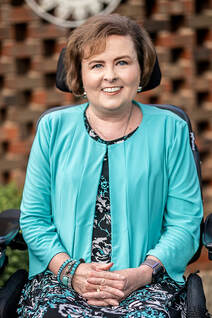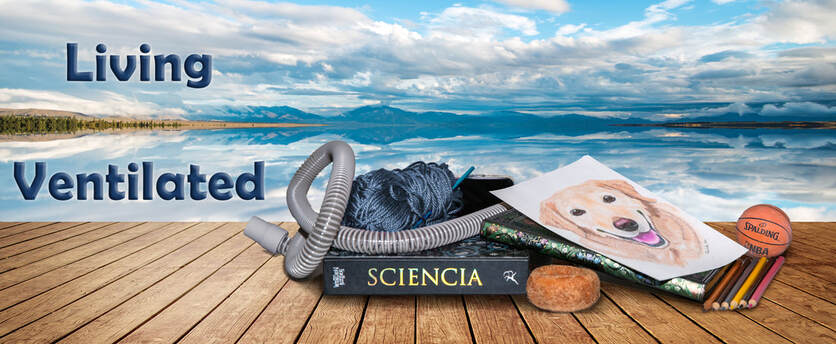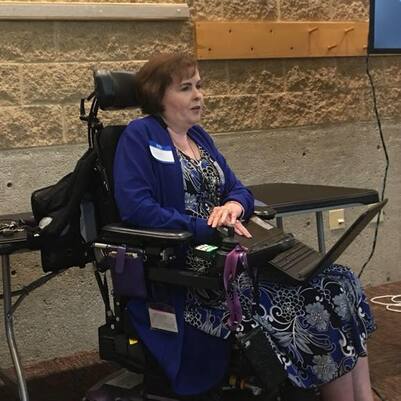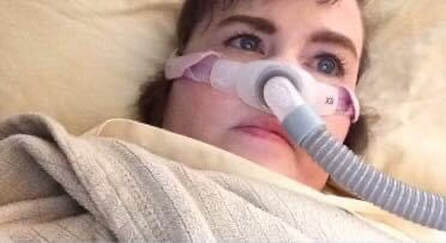|
By Andrea Klein Founder & President, Breathe with MD, Inc. "I genuinely believe they are all well-meaning and subscribe to the belief that we learn about and accept differences through questioning."  I’ve been using mechanical ventilation for breathing muscle weakness since December 2013, first as a basic BiPAP S/T with a backup rate. Then in July 2015, I transitioned to a multi-mode portable home use ventilator with AVAPS AE for night use and MPV (mouthpiece ventilation) for daytime use, as needed. I have many friends who also live with a Neuromuscular Disease (NMD) that have used a form of mechanical ventilation for much longer, some as much as 25-30 years. People can ask and say some unexpected things about mechanical ventilation. I genuinely believe they are all well-meaning and subscribe to the belief that we learn about and accept differences through questioning. For that reason, I don’t mind as this is an opportunity for me to educate those individuals. I hope that’s what this post does, teaches you something you didn’t know before reading it. Below is what people have said to me about mechanical ventilation and a summary of what my responses have been. 1. “Why not just use oxygen?” The primary issue when a Neuromuscular Disease (NMD) has weakened the muscles used to breathe and cough is that it becomes more difficult for air to move into and out of the lungs, a process called ventilation. When we fully support the process of moving air into and out of the lungs through mechanical ventilation, we prevent or resolve any oxygenation issues. Oxygen does not help move air into and out of the lungs and can actually create problems for those with weakened breathing muscles. Unventilated supplemental oxygen (used through a nasal cannula and without mechanical ventilation) led to my middle sister Cheryl’s death and is one of the most common inappropriate interventions for neuromuscular breathing weakness. You can learn more about the dangers of unventilated supplemental oxygen in this short video that I made, and be sure to visit the Oxygen Caution page of the Breathe with MD, Inc. website at https://breathewithmd.org/oxygen-caution.html. 2. “I wish I could sleep that much!” Getting adequate sleep is critical for health, but it’s even more important for those with weakened breathing muscles. When we use mechanical ventilation during sleep with adequate settings enabled, the bi-level respiratory device reduces or eliminates our effort to breathe during sleep so that we may achieve “breathing muscle rest.” The amount of time we need to sleep on our mechanical ventilation to achieve the ability to be alert, productive, and to remain off of our mechanical ventilation during the day varies from person to person. Any illness or symptom that arises overnight and interferes with sleep amount or quality can result in the need to prolong that sleep. Another factor is that many of us have a tendency to “overdo it” because our weakened limb muscles wear out before our drive for doing things does, often before we have realized our own limit. And that limit can vary from day to day and be influenced by many factors. Often, it’s not until the next day that we realize how worn out we are. The way we typically recover from this is to sleep more. Many of us also take longer to recover from illness, especially those of a respiratory nature, and that too means we may need to sleep more. 3. “I couldn’t do it; you are so brave!” Most of us that use mechanical ventilation for neuromuscular breathing weakness know we must use it to maintain our quality of life and/or prolong our life. Respiratory failure is the most common cause of death for someone living with an NMD, and many of us have seen this happen to our friends and loved ones, so we aren’t being brave. We are simply doing what we have to do to survive and thrive. 4. “I use CPAP too.” Ugh! This one gets old explaining. CPAP (one continuous positive airway pressure) and bi-level mechanical ventilation (two different levels of positive airway pressure, one for inhaling and another reduced one for exhaling) are not the same. CPAP can be harmful to those who live with an NMD and have weakened breathing muscles and does not assist in moving air into and out of the lungs. For a more detailed explanation, please watch my short video. 5. “Have you thought about getting an Inspire implant?” The Inspire implant is for individuals with obstructive sleep apnea. Those who live with neuromuscular breathing weakness may have sleep apnea, but typically that’s a misdiagnosis as the sleep study equipment and/or the reader of that study interprets their shallow, weak breathing effort as stopping to breathe (apnea) instead of simply a weak effort to breathe. Neuromuscular breathing weakness is not an obstruction; it’s a restrictive condition. Even if the individual living with an NMD has sleep apnea too, they would still need bi-level mechanical ventilation to ventilate their lungs, and this implant does not do that. 6. “Try inhaling essential oils, and you’ll breathe better!” There is no way that inhaling essential oils will make weakened breathing muscles suddenly work better. Anyone who tries to convince you of that is running a scam. 7. “Will you eventually need a lung transplant?” In neuromuscular breathing weakness, the primary issue is not with the lungs; the issue is with the muscles that move air into and out of the lungs, so a transplant would be pointless and not help. 8. “I was on a ventilator after my accident; it was awful!” I am sure that using a ventilator in the ICU or hospital via endotracheal intubation is frightening, especially for someone who has never experienced having a piece of equipment move air into and out of their lungs. In contrast, for someone with neuromuscular breathing weakness who connects their home use ventilator to a nasal, oronasal, full face, or nasal pillows mask, or a tracheostomy tube, we generally love our ventilators. They keep us alive and able to do what we need and want to do in and outside of the home. 9. “When I get to that stage, I just want to die.” This comment is a painful one for me to hear from someone who is living with an NMD because I know that whatever preconceived notion they have about mechanical ventilation is likely based on a lack of knowledge and/or inaccurate information. When someone is alive and able to be proactive about their care outside of a crisis, making a choice to simply die seems like they are needlessly giving up. I respect their right to make that decision, but I still do not like or agree with it. I believe we are all alive for a purpose, and that purpose does not end when we need mechanical ventilation. 10. “You’re going to get dependent on that and eventually be unable to breathe on your own.” My response to this is, “So what if I do?” If I need something to breathe in order to have quality of life and to prolong my life, I need it, so it isn’t going to matter if using it makes me eventually need it more. I’ve been using mechanical ventilation for just over eight and a half years, and the amount I currently need it each day versus when I started using it has not increased by more than two to three hours per day on average. This is going to vary from person to person, but we cannot allow fears of needing something more over time to prevent us from using it. Those are the 10 unexpected things people have said to me about mechanical ventilation. What unexpected things have people said to you? I would love to know. Editor's Note:
Are you an individual living with a Neuromuscular Disease (NMD) who uses mechanical ventilation and have a story to share about hospitalization, illness, emergencies, advanced medical testing (MRI, CT scan, etc.), or surgical procedures? Or, do you have another idea for a blog post? Start the process of helping others in the NMD community by telling us about it at https://breathewithmd.org/storyform.html, or send an email to [email protected].
Pat
7/20/2022 12:47:14 pm
Someone asked me if I still needed that stupid machine (meaning my bipap) to which my reply was that stupid machine helps me continue to live, so yes, I do and am grateful it exists!
Andrea
7/20/2022 10:00:36 pm
Wow. Not a nice thing to say at all... Our breathing equipment is life-saving and anything but stupid.
Paula Shal
7/24/2022 06:44:07 pm
Thank you for this post, Andrea. I have had a rough couple months and needed some inspiration as I seem to need daytime ventilation more and more and feel like I am losing so much independence.
Hi Paula, Comments are closed.
|
AboutLiving Ventilated celebrates those in the NMD community who use assisted ventilation. Archives
August 2024
Categories |
Note: This website should not be used as a substitute for medical care. For medical care or advice, please seek the care of a clinician who specializes in the breathing issues of those with Neuromuscular Disease (NMD).
Web Hosting by Hostgator




 RSS Feed
RSS Feed